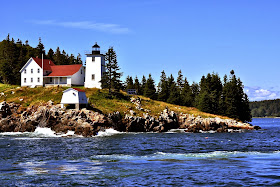 |
| Jeremy D'Entremont (In His Element) |
 |
| White Island Lighthouse (Isles of Shoals) |
 |
| Boon Island Lighthouse |
 |
| Cape Neddick (Nubble) Lighthouse |
 |
| Whaleback Lighthouse |
 |
| Portsmouth Lighthouse |
Over the years I have had a passion for photographing lighthouses in Maine and beyond. Please join me on a tour of the Maine lighthouses to which my wife and I have traveled. I will start way down east and take you all the way down the coast to the southern tip of Maine. I will try to include some history as well as directions to a spot from which the lighthouse can be viewed. I hope you enjoy our little journey.
 |
| Jeremy D'Entremont (In His Element) |
 |
| White Island Lighthouse (Isles of Shoals) |
 |
| Boon Island Lighthouse |
 |
| Cape Neddick (Nubble) Lighthouse |
 |
| Whaleback Lighthouse |
 |
| Portsmouth Lighthouse |
 |
| Jeremy Doing His Thing |
 |
| Having a Snack |
 |
| Bear Island Lighthouse |
 |
| Bass Harbor Head Lighthouse |
 |
| Blue Hill Bay Lighthouse |
 |
| Deer Island Thorofare (Mark Island) Lighthouse |
 |
| Eagle Island Lighthouse |
 |
| Faux Lighthouse off Stonington |
 |
| Goose Rocks Lighthouse |
 |
| Brown's Head Lighthouse |
 |
| Rockland Breakwater Lighthouse |
 |
| Owls Head Lighthouse |
 |
| Heron Neck Lighthouse |
 |
| Saddleback Ledge Lighthouse |
 |
| Isle au Haut (Robinson Point) Lighthouse |
 |
| Burnt Coat Harbor (Hockamock Head) Lighthouse - Swan's Island |
 |
| Great Duck Island Lighthouse |
 |
| Baker Island Lighthouse |
 |
| Winter Harbor (Mark Island) Lighthouse |
 |
| Egg Rock Lighthouse |
 |
| Waiting For The Boat |
 |
| In His Element |
 |
| Taking a Break |